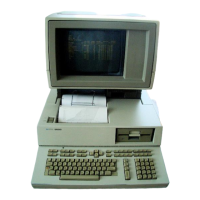3-4
Testing
and
Troubleshooting
Self-Tests and Diagnostics Overview
Three overlapping levels of diagnostics provide the primary service support tool for the computer.
These are the module self-tests, the self-test supervisory code (STSC), and the system functional
tests. The module self-tests
and
STSC are executed at powerup. The system functional tests are
contained
on
the System Functional Test
Discs
which can be loaded by the customer engineer.
Procedures for running module self-tests and STSC are contained
in
Appendix
B.
Procedures for
running the System Functional Test are contained
in
the System Functional Test User's manual.
A power-up condition or a SCRATCH
ALL
or LOAD
BIN
causes the power supply to generate a
signal to the processor stack that puts the stack
in
self-test mode. When stack self-test
is
completed,
the stack signals
all
internal modules on the
liD
interface to begin their self-tests. The STSC begins
executing
its
tests when the module self-tests are completed.
Module Self-Tests
The
first
level of diagnostics consists of the module self-tests. Self-tests are contained
in
the replace-
able modules
and
are initiated
on
powerup. (The BASIC language system SCRATCH
ALL
or
LOAD
BIN
command causes the execution of
all
module self tests, except the processor stack tests.
No eqUivalent
HP-UX commands exist.) The user can initiate execution of some self-tests on an
individual basis.
In
most cases, LEDs
on
the modules indicate the results. On some modules, more
information
is
available via a self-test status register which
is
accessible via the operating system.
Module self-tests provide low level diagnostics which can diagnose a problem to the replaceable
module level even
if the CPU or lOP bus has also failed. Each module's self-test
is
independent of
the functionality of other modules.
Self-Test Supervisory Code
The STSC
is
resident
in
the operating system. The device driver calls the STSC for each module,
and
the STSC reports the status of the module. The STSC resides
in
the device driver itself
in
some
cases, verifying the integrity of the interface
and
passing the test results to the operating system.
The
STSC verifies the
liD
interconnection between the lOP
and
the internal
liD
devices, reads the
self-test status registers of those modules, and reports any errors to the user. The code enhances the
module self-tests by further module testing.
Several output devices indicate successful completion of the tests. Thus, the failure of a single
output device can
be
distinguished from the failure of another device's self-test.
System Functional Tests
System Functional tests are compiled programs that run
on
the BASIC 2. a operating system. (The
tests can also run
on
a special test operating system that
is
on
the discs with the tests. This
is
for
HP
use only). The programs are capable of testing
all
internal computer hardware
and
liD
cards to at
least a
95%
confidence level. The information returned
is
detailed enough to enable isolation to a
field-replaceable module. The programs reside
on
flexible discs,
and
the procedures are
in
the
System Functional Test
User's manual.
09020-90037.
rev
U~5

